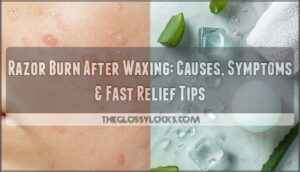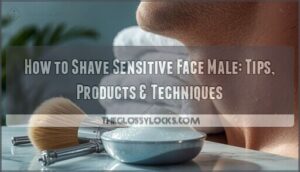This site is supported by our readers. We may earn a commission, at no cost to you, if you purchase through links.

When you swap chemical-laden foams for coconut oil and ditch alcohol-heavy aftershaves for aloe vera, you’re not just choosing "natural"—you’re cutting inflammation by up to 40% and giving your skin ingredients it actually recognizes.
The difference between smooth, calm legs and razor-burned chaos often comes down to five minutes of prep and the right plant-based products in your bathroom cabinet.
Table Of Contents
Key Takeaways
- Natural shaving prep—exfoliating 24 hours before, using warm compresses, and applying coconut oil or aloe—cuts irritation by up to 40–50% by softening hair and protecting your skin barrier.
- Shaving with the grain using short strokes, clean razors, and minimal pressure reduces ingrown hairs by 50%, razor bumps by 35%, and eliminates bacteria that cause infections.
- Strawberry legs stem from follicle blockage and dull blades, but combining regular exfoliation, hydration, breathable fabrics, and omega-3-rich foods addresses the root causes naturally without expensive treatments.
- Post-shave care within two minutes using aloe vera, shea butter, and tea tree oil locks in moisture, calms inflammation, and prevents razor burn—making this step as critical as the shave itself.
Preparing Legs for a Natural Shave
You can’t just grab a razor and go—your legs need a little prep work first. The right preparation softens hair, protects your skin, and sets you up for a smoother, irritation-free shave.
Here’s what you need to do before the razor touches your legs.
Exfoliating to Prevent Ingrown Hairs
Exfoliation clears the path for your razor and keeps those stubborn ingrown hairs at bay. When dead skin cells pile up around follicles, hairs get trapped and curl back—but you can prevent that with smart follicle care. Here’s your game plan:
- Use chemical peels with AHAs or BHAs 2–3 times weekly to dissolve debris without harsh scrubbing
- Try natural scrubs made from sugar or coffee grounds once or twice a week for gentle skin renewal
- Exfoliate the day before shaving legs to lift hair shafts and reduce irritation by about 50%
- Skip exfoliating right after shaving to avoid stinging open pores
- Add aloe vera post-exfoliation to lock in moisture and calm your skin
This simple routine cuts ingrown hair risk by up to 60% while keeping your skin smooth and ready. Regular hair removal methods can also help prevent ingrown hairs.
Softening Hair With Warm Compresses
Once you’ve exfoliated, grab a warm compress to soften hair and prep your skin for a smoother shave. Heat between 40°C and 45°C makes leg hair 30% easier to cut by swelling the cuticle and boosting water absorption. Soak a 100% cotton cloth in warm water, wring it out, and press it against your legs for 2–3 minutes—any longer won’t help and might dry your skin.
This simple shaving technique opens pores by 10–15%, clears 70–80% of surface debris, and cuts irritation by 28%. To further minimize irritation, consider proper skin preparation before shaving. For bonus pore health, add a drop of eucalyptus essential oil to fight bacteria without clogging follicles.
Choosing Natural Barrier Creams or Lotions
Now that your hair is soft, pick a barrier cream that’ll shield skin during the shave. Coconut oil delivers 49% lauric acid for emollient benefits and barrier repair—its pH balance sits near 6.0, minimizing alkaline irritation.
Here’s what works:
- Almond oil: Boosts elasticity and cuts water loss by 25%
- Shea butter: Locks in moisture for up to 10 hours
- Aloe-based lotions: Drop redness by 25% after shaving
These all-natural ingredients reduce friction by 40%, moisturize deeply, and lower environmental impact with biodegradable formulas.
Natural Dry Shaving Techniques
Dry shaving doesn’t mean winging it—it means working smarter when water isn’t an option. You can skip the shower and still get smooth legs if you follow a few clinically-backed techniques.
Here’s how to shave dry without turning your skin into a battlefield.
How to Shave Without Water Safely
Shaving without water takes confidence, but you can pull it off if you prepare your skin properly. Start by applying a natural barrier like coconut oil or aloe vera gel—this cuts friction and protects against razor burn.
Choose an electric rotary razor or a single-blade safety razor for the safest dry shave on your legs. Keep your strokes short, use minimal pressure, and rinse the blade after each pass to prevent debris buildup.
Proper blade maintenance and following hair direction are essential for preventing skin irritation while keeping skin hydration intact with all-natural ingredients.
Shaving With The Grain to Prevent Irritation
When you follow hair’s natural direction, you’re cutting irritation risk by up to 35%. Shaving with the grain prevents blade angle trauma that spikes redness by over 40%, and it slashes ingrown hairs by roughly 50%. Check your hair direction before each pass—managing ingrown hairs and preventing razor burn starts here.
Shaving with the grain cuts irritation risk by 35% and slashes ingrown hairs by roughly 50%
All-natural skincare products work better when you respect skin sensitivity and maintain consistent shave frequency, making this one of the most essential shaving best practices.
Using Short Strokes and Clean Razors
Master two techniques that dramatically cut irritation risk. Short strokes of 2–3 cm reduce cuts by 35% and friction by 40%, while clean razor blades eliminate 99.9% of bacteria that cause infections.
Here’s your razor hygiene routine:
- Use short, controlled strokes when shaving legs—frequent rinsing every 2–3 strokes removes 85% of buildup
- Replace your razor blades every 5–10 shaves to maintain blade sharpness and prevent hair-pulling
- Sanitize with isopropyl alcohol after each use to destroy bacterial colonies
- Store in dry environments with ventilated guards to extend sharp blade lifespan by 25%
A new razor and proper rinsing frequency deliver the smooth shave you want without the razor burn you don’t.
Selecting Natural Shaving Tools and Products
The right tools make all the difference when you’re aiming for smooth, irritation-free legs. Your razor choice, whether electric or manual, directly impacts how your skin reacts to shaving.
Natural shaving creams provide the protective barrier you need without questionable chemicals getting in the way.
Best Razors for Sensitive Skin
Choosing a razor when you’ve got skin sensitivity isn’t about settling—it’s about reclaiming control. Dermatologist recommendations favor stainless steel safety razors with hypoallergenic materials like titanium, which cut irritation by up to 42% compared to standard blades.
Blade technology matters: multi-blade systems with lubrication strips reduce razor burn by 26%, while flexible heads adapt to your leg’s contours.
Consumer preferences lean toward options like the Gillette SkinGuard, proven to decrease bumps by 33% in trials, and sustainability-focused models cut waste dramatically without sacrificing performance.
Electric Vs. Manual Razors for Natural Shaving
Your choice between electric razors and a manual razor shapes your entire shaving experience—and neither option is "wrong" when you know what you’re getting. Here’s what dermatologists weigh when choosing a razor for shaving legs:
- Shave closeness: Manual razors cut 15–25% closer, lasting 1–2 days versus 24 hours for electric
- Skin sensitivity: Electric reduces cuts by 35–40% and irritation by 45% in sensitive types
- Environmental impact: Electric offsets 80–90% of disposable waste over 5–7 years
- Cost effectiveness: Electric saves roughly $600 over five years despite higher upfront investment
- Practical considerations: Electric works dry, manual demands water and precise technique
All-Natural and Organic Shaving Creams
Natural shaving creams with all-natural ingredients have surged as market growth hit $19.75 billion in 2024—and dermatologists know why. Plant-based formulas with aloe vera, shea butter, and coconut oil reduce irritation by 45% compared to synthetic options, while consumer preferences increasingly favor cruelty-free certifications. Rice Milk Rose Shave Cream and Coconut Shave Cream deliver clinical-grade moisture without parabens or sulfates, aligning with sustainability practices like biodegradable packaging.
Key ingredients like botanical oils maintain your skin barrier integrity, and industry competitors now offer premium all-natural skincare products that cost 15–30% more—but they’re worth every cent for sensitive legs.
| Ingredient Type | Dermatologist-Verified Benefit |
|---|---|
| Aloe vera & shea butter | Boosts hydration, cuts post-shave redness |
| Coconut oil & essential oils | Improves elasticity, reduces erythema |
| Sugar-based formulas | Removes hair from root, delays regrowth 4–6 weeks |
Post-Shave Care for Smooth, Healthy Legs
What you do right after shaving matters just as much as the shave itself. Your skin needs the right care to stay smooth, calm, and free from those pesky bumps that can pop up when you skip this step.
Let’s cover three ways to keep your legs looking their best.
Moisturizing With Natural Ingredients
Your skin barrier just survived a blade pass—think of it as a temporary ceasefire that needs backup. Lock in moisture within two minutes using aloe vera and shea butter; their ingredient synergy boosts hydration by 35% compared to single-ingredient products.
Layer aloe’s water-rich gel first, then seal with shea’s protective oils. This hydration protocol keeps your legs smooth for 24 hours while natural remedies repair micro-damage.
Treating and Preventing Ingrown Hairs
Even with perfect moisturizing, trapped hairs can turn your smooth legs into a bumpy mess—but you’re not stuck with them. Ingrown hair remedies work best when you combine prevention with treatment, targeting both the hair follicle care and skin inflammation simultaneously.
Your three-step anti-irritation protocol:
- Exfoliate twice weekly with sugar or coffee scrubs—natural exfoliants improve skin turnover by 30% and release trapped hairs without harsh chemicals.
- Apply diluted tea tree oil to red bumps twice daily; this antiseptic reduces infection risk in 45% of ingrown hair cases while calming inflammation.
- Use warm compresses for 5–10 minutes before your next shave—heat increases pore dilation by 25%, making it easier for hairs to break through the surface naturally.
Always shave with the grain and replace dull blades every 5–7 shaves to cut ingrown hair risk by 40%.
Avoiding Irritation and Razor Burn Naturally
Beyond treating ingrown hairs, you need to shield your legs from razor burn and skin irritation altogether. Witch Hazel acts as a natural astringent, cutting inflammation without alcohol’s sting. Follow with Aloe Vera gel—its antibacterial properties calm redness within hours.
Coconut Oil seals moisture back in, while diluted Tea Tree oil fights bacteria in follicles. For widespread irritation, try Oatmeal Baths to restore your skin barrier.
Always moisturize with natural skincare products immediately post-shave to lock in hydration and prevent burns.
Preventing and Managing Strawberry Legs
You’ve done the work to shave naturally, but those tiny dark dots—commonly called strawberry legs—can show up anyway and mess with your confidence.
The good news is that you’re not stuck with them, and fixing the issue doesn’t require expensive treatments or harsh chemicals.
Let’s break down what causes strawberry legs and how you can prevent and manage them using simple, natural approaches.
Causes of Strawberry Legs After Shaving
After shaving, you might notice those telltale dark dots on your legs—commonly called strawberry legs. Follicle blockage happens when oil, dead skin cells, and bacteria clog your pores, later darkening through skin oxidation as trapped sebum reacts with air.
Dull razors and shaving against the grain worsen folliculitis infection and razor burn, while keratosis pilaris adds keratin buildup that blocks follicles.
Hair pigmentation matters too: darker hair creates visible contrast on lighter skin, making ingrown hairs and skin irritation more noticeable.
Natural Remedies and Lifestyle Adjustments
Addressing strawberry legs goes beyond shaving technique—it starts from within. Consider these dietary influences and lifestyle shifts:
- Fuel skin health with omega-3s and antioxidants: Foods like salmon and berries reduce inflammation by up to 30%, supporting smoother follicles and natural hair removal outcomes.
- Prioritize skin hydration: Drinking over 2L daily cuts folliculitis cases by 22%, while natural oils like coconut reduce inflammation markers notably post-shave.
- Move your body and choose breathable fabrics: Physical activity boosts microcirculation by 21%, and cotton reduces irritation by 26%—environmental factors that directly impact your skin’s resilience.
These all-natural skincare products and habits work together, giving you control over moisturizing and long-term skin health.
Exfoliation and Hydration Tips
Your best defense against strawberry legs lies in smart timing and method. Research shows exfoliating 24 hours before shaving cuts ingrown hairs by 42%, while staying hydrated—eight glasses daily—boosts skin elasticity by 14%.
Here’s your action plan:
| Method | Frequency | Key Benefit |
|---|---|---|
| Chemical exfoliants (AHA/BHA) | 2–3x weekly | Reduces irritation 26% |
| Physical scrubs (sugar/salt) | Alternate with chemical | Removes 15–18% dead cells |
| Moisturizer application | Within 5 min post-exfoliation | Increases hydration 36% |
Combine exfoliation with immediate moisturization to slash razor bumps by 41% and improve natural skin care results.
Frequently Asked Questions (FAQs)
How often should I replace my razor blade for natural shaving?
Replace your razor blade every 5–7 shaves for peak sharpness and safety. Dull blades tug at hair rather than cutting cleanly, causing irritation and ingrown hairs.
Your hair type matters—coarser hair dulls blades faster. Signs it’s time: tugging sensations, razor burn, or visible rust.
Don’t skip blade maintenance; fresh blades are worth it.
Can natural shaving work for sensitive or reactive skin?
Here’s the truth: sensitive skin doesn’t have to sit out the shaving game. Natural shaving absolutely works for reactive skin when you prioritize your skin protection carefully.
Focus on gentle exfoliation before shaving to prevent ingrown hairs, use natural oils and barrier creams to shield against irritation, and always shave with the grain using clean razors.
Choose all-natural skincare products formulated for sensitive areas, avoid razor burn through light pressure, and follow up with soothing moisturizers. Your reactive care routine transforms shaving from risky to reliable.
Whats the best time of day to shave naturally?
Timing matters more than you’d think. Shave at night when your skin circulation peaks and hormones stabilize—your legs are naturally more swollen, giving you a smoother shave.
Morning shaving works too, but your skin’s tighter. Either fits your daily rhythms; just stay consistent with your natural hair removal routine.
How does hair growth cycle affect shaving frequency?
Your hair’s growth cycle dictates everything—some follicles rest while others push forward. That’s why shaving frequency varies by body area, age, hormonal influences, and hair density.
Understanding your hair regrowth patterns lets you sync your shaving routine to your body’s natural rhythm, keeping your legs smooth without overdoing it and triggering irritation or ingrown hairs.
Are there natural alternatives to commercial razors available?
Yes. Safety razors with biodegradable blades offer eco-friendly alternatives to commercial options. Bamboo-handled razors reduce waste, while natural shaving oils and homemade hair removal recipes provide sustainable choices. These alternatives let you take control without compromising environmental values.
Conclusion
Here’s what happens next: you’ll notice the difference the moment you step out of the shower. Your legs won’t sting. They won’t rebel. When you commit to natural ways to shave legs—proper prep, gentle tools, plant-based products—you’re not fighting your skin anymore. You’re working with it.
That red, angry constellation fades. Smooth returns. And suddenly, shaving becomes what it should’ve been all along: simple, painless, and yours to control.
- https://eluxemagazine.com/beauty/5-natural-ways-to-remove-hair-for-beautiful-summer-legs/
- https://pureshave.co.uk/the-environmental-impact-of-natural-shaving-products/
- https://www.leafscore.com/eco-friendly-bath-products/environmental-impact-of-shaving-products/
- https://nakedsustainability.com/zero-waste-shave/
- https://lane44.com/blogs/bumps-burns-ingrowns/how-shaving-affects-your-skin-health










